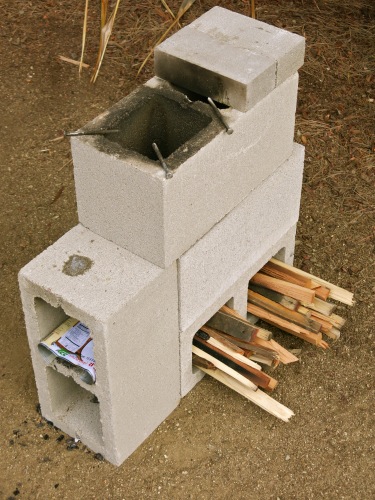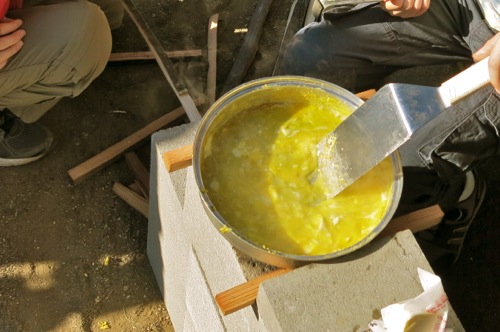This past Sunday, the middle school ecojustice Sunday school class cooked on rocket stoves. We based our stoves on design principles developed by Dr. Larry Winiarski, who is affiliated with the Aprovecho Research Center. A rocket stove makes more efficient use of biomass fuels (wood, twigs) through more complete combustion; this also results in fewer harmful emissions. According to the Aprovecho Research Center:
“Improved cooking stoves address at least 5 of the 8 United Nations’ Millennium Development Goals: [1] ending poverty and hunger; [2] gender equity; [3] child health; [4] maternal health; and [5] environmental sustainability.”
So while we don’t really need rocket stoves here in the Bay area (except perhaps in disaster situations), learning about and building them is a great introduction to using appropriate technology to meet ecojustice goals of human well being and environmental sustainability.
If you’re not familiar with rocket stove design principles,Aprovecho Research Center has an excellent introduction on this Web page. Scroll down and click on document no. 8, “Design Principles for Wood Burning Cook Stoves,” June, 2005.
Enough background. Here are instructions for building a concrete block rocket stove, followed by photos of our rocket stove in action:
Click the image above for a drawing of how to build our concrete block rocket stove. You will find other plans for a concrete block rocket stove on the Web, but those plans typically require a concrete h-block, an oddball type of block that we were unable to find. However, most bit home improvement stores carry 8 x 2 x 16 inch concrete cap blocks, and 4 x 2 x 8 inch concrete brick — two cap blocks and two concrete brick can be arranged in an “H” shape to make a stove. In fact, this is a better solution than a concrete H-block, because you can adjust the concrete brick such that you have a constant cross-sectional area throughout the L-shaped combustion chamber (see “Design Principles for Wood Burning Cook Stoves,” principle 7).

Above: The concrete block rocket stove after use. We placed two concrete bricks on the top on which to place cooking implements, etc. The bottom concrete block serves as a convenient place to store fire wood. Notice that our firewood is all salvaged building materials and wood pallets, split to appropriate size for burning.

Above: Cooking on the stove. “Design Principles for Wood Burning Cook Stoves” states that a combustion chamber with a 12 x 12 cm cross sectional area is “usually sufficient for a family sized cooking stove.” Our concrete block rocket stove has a cross sectional area of 12.5 x 15 cm. It put out a good amount of heat for cooking scrambled eggs for half a dozen people. Note that one person is feeding the fuel into the stove, while the other cooks — we found it was challenging to cook and tend the fire at the same time.
We did not try to boil water on our concrete block rocket stove, to see how long that would take. Maybe that’s a task for a future class.
Update, one year on: This has proved to be a good, but not excellent, rocket stove design. The chief problem with this design is that the concrete block acts as a fairly large thermal mass, and it takes a while to heat the block. Once the block is warm, the stove functions pretty efficiently; while the block is still cook, it’s not as good. Another problem is that the stove is finicky, and requires constant attention to feeding fuel in order to maintain a fairly constant temperature. Nevertheless, given the low cost of materials, and the ease of construction, this remains a practical design.


Why aren’t we using this at the house?
–utility bill payer
Re: the absorbtion of heat.
Would you be able to eliminate this to some degree by placing tin cans in the chimney and thus shielding the blocks and creating a better airflow by providing a smooth surface as opposed to the course blocks.
Ken, maybe. You could use cans backed by Perlite as insulating material, to create an insulated chimney — I’ve made small rocket stoves from tin cans where Perlite is used as an insulating material, and that works pretty well. Admittedly, it would take some creative metal work to get the Perlite to stay where you want it, but it could be done.
In practice, the concrete block rocket stove works reasonably well as it is, especially considering the low cost and the small amount of effort it takes to build one. I’ve been using them for 6 years now in summer camp programs, and I’d say they’re quite adequate for infrequent use, or for emergency use. One caveat — the concrete blocks eventually split due to the heat. I think I’m on my third set of concrete blocks in six years of desultory use.
But if you want to cook regularly on a rocket stove, invest the time and money and build one of the more permanent designs from Arpovecho Institute.
Thank YOU for the reply. I enjoyed the article and I always appreciate good information like that.
I didn’t realize that the blocks had the ability to last that long. Thanks again.
Would another CB on top not significantly increase heat and improve efficiency by forming a longer chimney, thereforemore of a jet effect?
CJ, that’s a good idea, and definitely worth experimenting with. Probably start off increasing the length of the chimney in 4 inch increments using concrete bricks. Start a fire, and watch for two things: the color of the flames where they emerge from the chimney (if they’re not orange, you’ve got complete combustion), and whether the flames are long enough to wrap around the width of the pot but not up the sides. Keep increasing the length of the chimney until you have the optimum effect.
I think maybe I’ll fire up the rocket stove this weekend and see what I can do….
I took in all your thoughts, views and comments and built this…..!
https://www.youtube.com/watch?v=2lY5YI2R1HU
It has an extra high 4th block, central lined flue, made with steel gutter fixed together, a bottom grate, is cemented together, soon rendered too, fixed open air way, made with a steel gas bottle, with the ends cut off, it has a steep fill chute, cemented in, over the top of it and flames rocket out, when filled and burning….!
Clive, nice design, great video. Thanks for posting the link here!